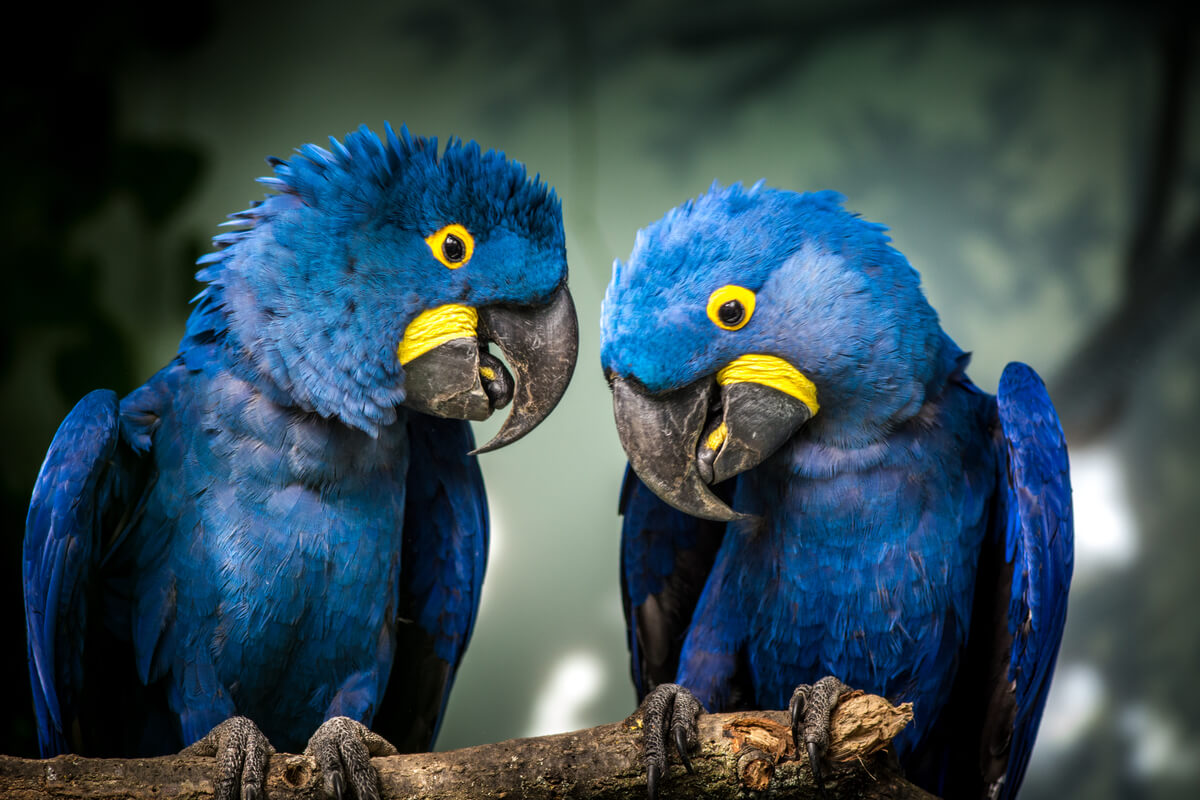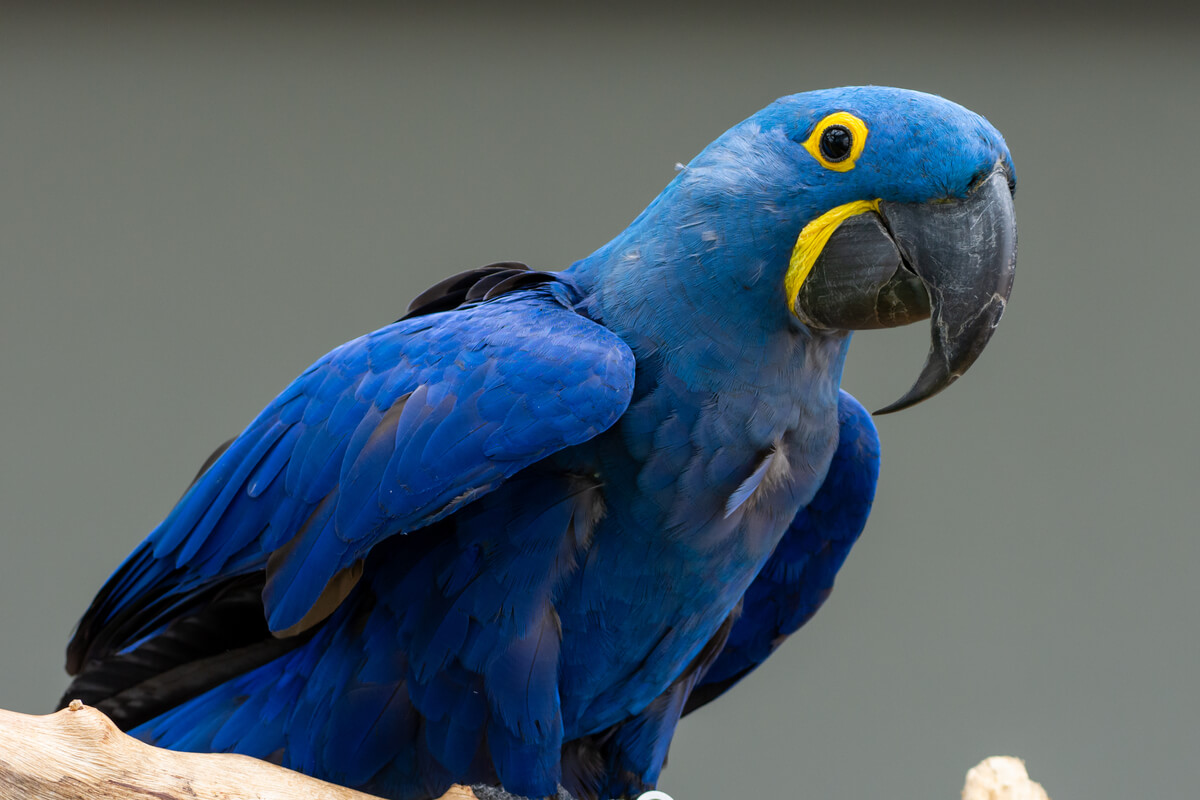Blue Macaw: Habitat and Characteristics

Many brightly colored birds, such as the blue macaw, can be found in South America. This beautiful bird inhabits a good part of Brazil, Bolivia and the north of Paraguay. In addition, it should be noted that it’s the largest species within the group of macaws.
Unfortunately, today this species is in a vulnerable state. Poachers make research on this animal increasingly difficult, as well as knowledge of its behaviors and characteristics. Read on to find out more about the blue macaw.
Physical characteristics of the blue macaw
The blue macaw (Anodorhynchus hyacinthinus) is a psittaciform bird belonging to the Psittacidae family. Within this group, we find the birds commonly known as parrots. In turn, this family includes macaws and other similar birds, located in America and Africa.
When comparing these birds, it’s easy to conclude that they all share a number of common characteristics. The blue macaw stands out from the rest for its gorgeous colors and behavior, among other things. If you want to know more about it, keep reading.

1. The blue macaw is the largest parrot of all
Compared to the rest of its relatives, Anodorhynchus hyacinthinus reaches 90-100 centimeters in length and a wingspan of up to 140 centimeters. This makes it the largest parrot currently known. In addition, its weight ranges between 1.5 and 1.7 kilos, a not inconsiderable figure for a bird.
2. Its intense blue hue is unmistakable
The colorful hue of this macaw makes it an irresistible visual target for tourists. Its powerful blue tone – reminiscent of indigo – spreads to its wings and very long tail, the underside of which is black.
In addition, at the base of the beak and its adjoining side, the periocular ring shows a yellow color. Because of all the above, this species is included within the group of most colorful birds, along with the rainbow parrot and others.
3. Its curved and pointed beak is adapted to its feeding
Charles Darwin determined that birds’ beaks fulfill an essential function: they’re a key tool in their diet. In the case of the blue macaw, their main food is walnuts. This fruit comes from different palms, depending on the region the bird resides in.
Studies show that these birds can pick up palm nuts from the ground or tear them off the plant. In addition, they complete their diet with fruits from the genus Ficus sp. (figs), as well as freshwater gastropod mollusks of the genus Pomacea.
Thanks to the strength of its black beak, this bird can split the nuts and the rest of the foods that make up its diet.
4. They don’t show sexual dimorphism
It isn’t possible to differentiate males from females with the naked eye. Therefore, we see that this species doesn’t show any visible sexual dimorphism. Although they seem to be almost indistinguishable, the females have the peculiarity of being more slender.
5. Habitat and behavior
The distribution of this species extends into the interior of South America, although between widely separated areas. Normally, they’re to be found in tropical regions, formed by different species of palm trees with large seeds. Within these regions, it prefers those with low humidity or seasonal humidity.
For example, this bird can be found in lowland Brazilian Amazon forests and rocky valley plateaus in northeastern Brazil.
Behavior of the blue macaw
- This bird performs migratory movements.
- It lives in different social structures: as a couple, a family group or small flocks of up to 10 individuals.
- Blue macaws have favorite trees to nest in: especially in the genera Enterolobium and Sterculia.
- The males “collaborate” in the incubation: throughout the month of incubation, the male is in charge of taking care of his mate.
- Even if they lay 2 eggs, normally only one survives: the egg that hatches earlier has the highest chances of surviving, since the second hatchling cannot compete for food, being weaker.
- They imitate and repeat words from 6-7 months: it’s believed that, after 2 years, these birds are able to understand what they say.
State of conservation
Currently, the blue macaw is part of the list of vulnerable species. Specifically, this situation stems from the excess of catches for commercial purposes, as well as the use of their feathers to make accessories.
In addition, like the rest of the animals that make up the wild fauna of the regions where they live, humans have endangered their habitat. Especially significant are the fires through which people try to obtain farmland, which end up destroying nests of this and other species.
All this has caused this species to be in a state of population decline.

In short, the blue macaw is a bird with a hue that’s irresistible to humans. However, their current state is a serious one, and we need to curb their threats, in order to prevent a species as beautiful as this one from disappearing.
With the intention of raising awareness among the population, Bolivia has decided to include this species on its 100 Bolivian banknotes. In this way, government entities are trying to hold people accountable for their actions and promote the protection of this and other species.
Many brightly colored birds, such as the blue macaw, can be found in South America. This beautiful bird inhabits a good part of Brazil, Bolivia and the north of Paraguay. In addition, it should be noted that it’s the largest species within the group of macaws.
Unfortunately, today this species is in a vulnerable state. Poachers make research on this animal increasingly difficult, as well as knowledge of its behaviors and characteristics. Read on to find out more about the blue macaw.
Physical characteristics of the blue macaw
The blue macaw (Anodorhynchus hyacinthinus) is a psittaciform bird belonging to the Psittacidae family. Within this group, we find the birds commonly known as parrots. In turn, this family includes macaws and other similar birds, located in America and Africa.
When comparing these birds, it’s easy to conclude that they all share a number of common characteristics. The blue macaw stands out from the rest for its gorgeous colors and behavior, among other things. If you want to know more about it, keep reading.

1. The blue macaw is the largest parrot of all
Compared to the rest of its relatives, Anodorhynchus hyacinthinus reaches 90-100 centimeters in length and a wingspan of up to 140 centimeters. This makes it the largest parrot currently known. In addition, its weight ranges between 1.5 and 1.7 kilos, a not inconsiderable figure for a bird.
2. Its intense blue hue is unmistakable
The colorful hue of this macaw makes it an irresistible visual target for tourists. Its powerful blue tone – reminiscent of indigo – spreads to its wings and very long tail, the underside of which is black.
In addition, at the base of the beak and its adjoining side, the periocular ring shows a yellow color. Because of all the above, this species is included within the group of most colorful birds, along with the rainbow parrot and others.
3. Its curved and pointed beak is adapted to its feeding
Charles Darwin determined that birds’ beaks fulfill an essential function: they’re a key tool in their diet. In the case of the blue macaw, their main food is walnuts. This fruit comes from different palms, depending on the region the bird resides in.
Studies show that these birds can pick up palm nuts from the ground or tear them off the plant. In addition, they complete their diet with fruits from the genus Ficus sp. (figs), as well as freshwater gastropod mollusks of the genus Pomacea.
Thanks to the strength of its black beak, this bird can split the nuts and the rest of the foods that make up its diet.
4. They don’t show sexual dimorphism
It isn’t possible to differentiate males from females with the naked eye. Therefore, we see that this species doesn’t show any visible sexual dimorphism. Although they seem to be almost indistinguishable, the females have the peculiarity of being more slender.
5. Habitat and behavior
The distribution of this species extends into the interior of South America, although between widely separated areas. Normally, they’re to be found in tropical regions, formed by different species of palm trees with large seeds. Within these regions, it prefers those with low humidity or seasonal humidity.
For example, this bird can be found in lowland Brazilian Amazon forests and rocky valley plateaus in northeastern Brazil.
Behavior of the blue macaw
- This bird performs migratory movements.
- It lives in different social structures: as a couple, a family group or small flocks of up to 10 individuals.
- Blue macaws have favorite trees to nest in: especially in the genera Enterolobium and Sterculia.
- The males “collaborate” in the incubation: throughout the month of incubation, the male is in charge of taking care of his mate.
- Even if they lay 2 eggs, normally only one survives: the egg that hatches earlier has the highest chances of surviving, since the second hatchling cannot compete for food, being weaker.
- They imitate and repeat words from 6-7 months: it’s believed that, after 2 years, these birds are able to understand what they say.
State of conservation
Currently, the blue macaw is part of the list of vulnerable species. Specifically, this situation stems from the excess of catches for commercial purposes, as well as the use of their feathers to make accessories.
In addition, like the rest of the animals that make up the wild fauna of the regions where they live, humans have endangered their habitat. Especially significant are the fires through which people try to obtain farmland, which end up destroying nests of this and other species.
All this has caused this species to be in a state of population decline.

In short, the blue macaw is a bird with a hue that’s irresistible to humans. However, their current state is a serious one, and we need to curb their threats, in order to prevent a species as beautiful as this one from disappearing.
With the intention of raising awareness among the population, Bolivia has decided to include this species on its 100 Bolivian banknotes. In this way, government entities are trying to hold people accountable for their actions and promote the protection of this and other species.
All cited sources were thoroughly reviewed by our team to ensure their quality, reliability, currency, and validity. The bibliography of this article was considered reliable and of academic or scientific accuracy.
- Guacamayo Jacinto. (2020, 30 abril). Mascotas. https://www.mascotarios.org/guacamayo-jacinto/
- Guacamayo Azul (Anodorhynchus hyacinthinus). (2021). NaturaLista.co. https://colombia.inaturalist.org/taxa/18938-Anodorhynchus-hyacinthinus
- BirdLife International (BirdLife International). (2016, 1 octubre). Hyacinth Macaw, Anodorhynchus hyacinthinus. IUCN Red List of Threatened Species. https://www.iucnredlist.org/species/22685516/93077457
This text is provided for informational purposes only and does not replace consultation with a professional. If in doubt, consult your specialist.








